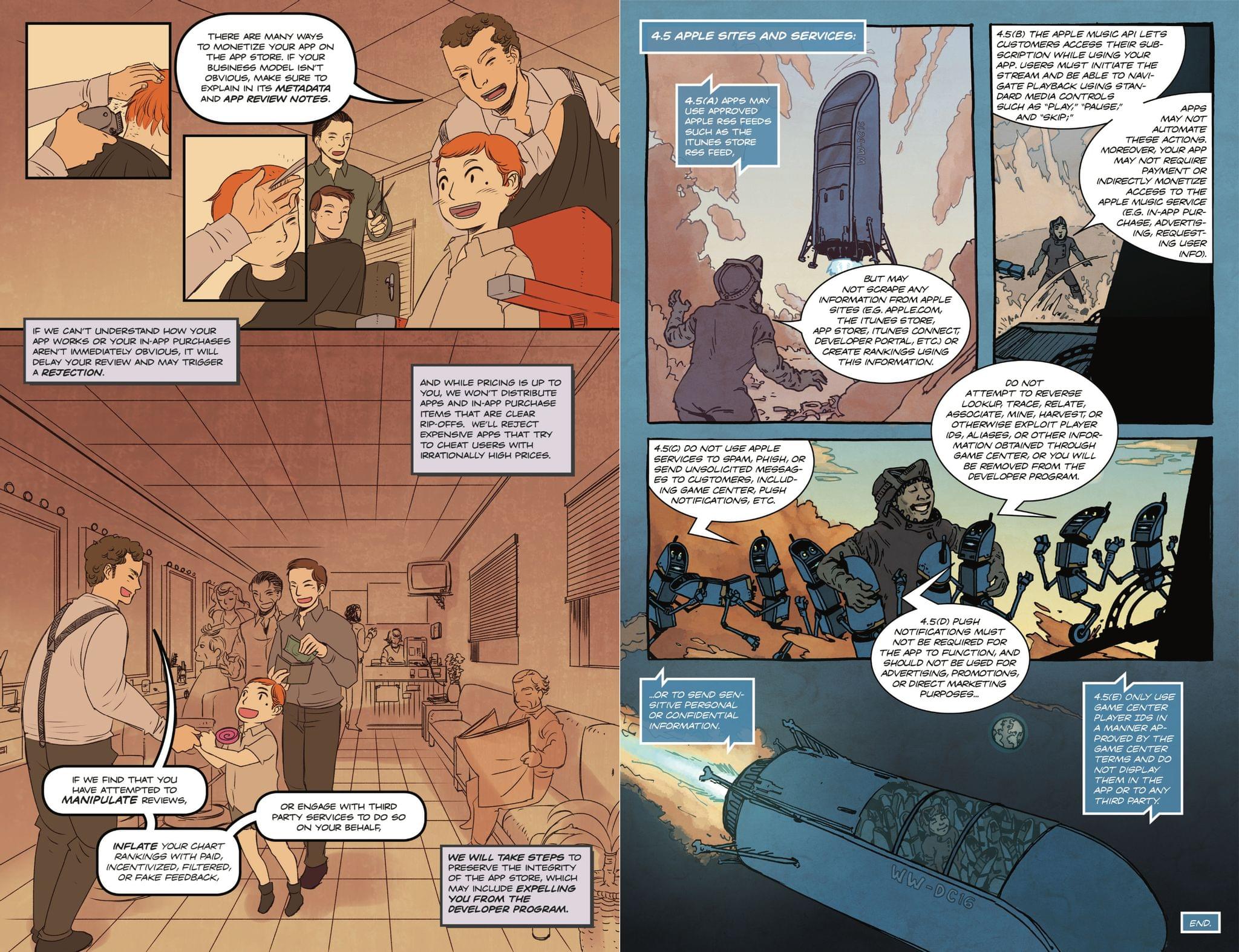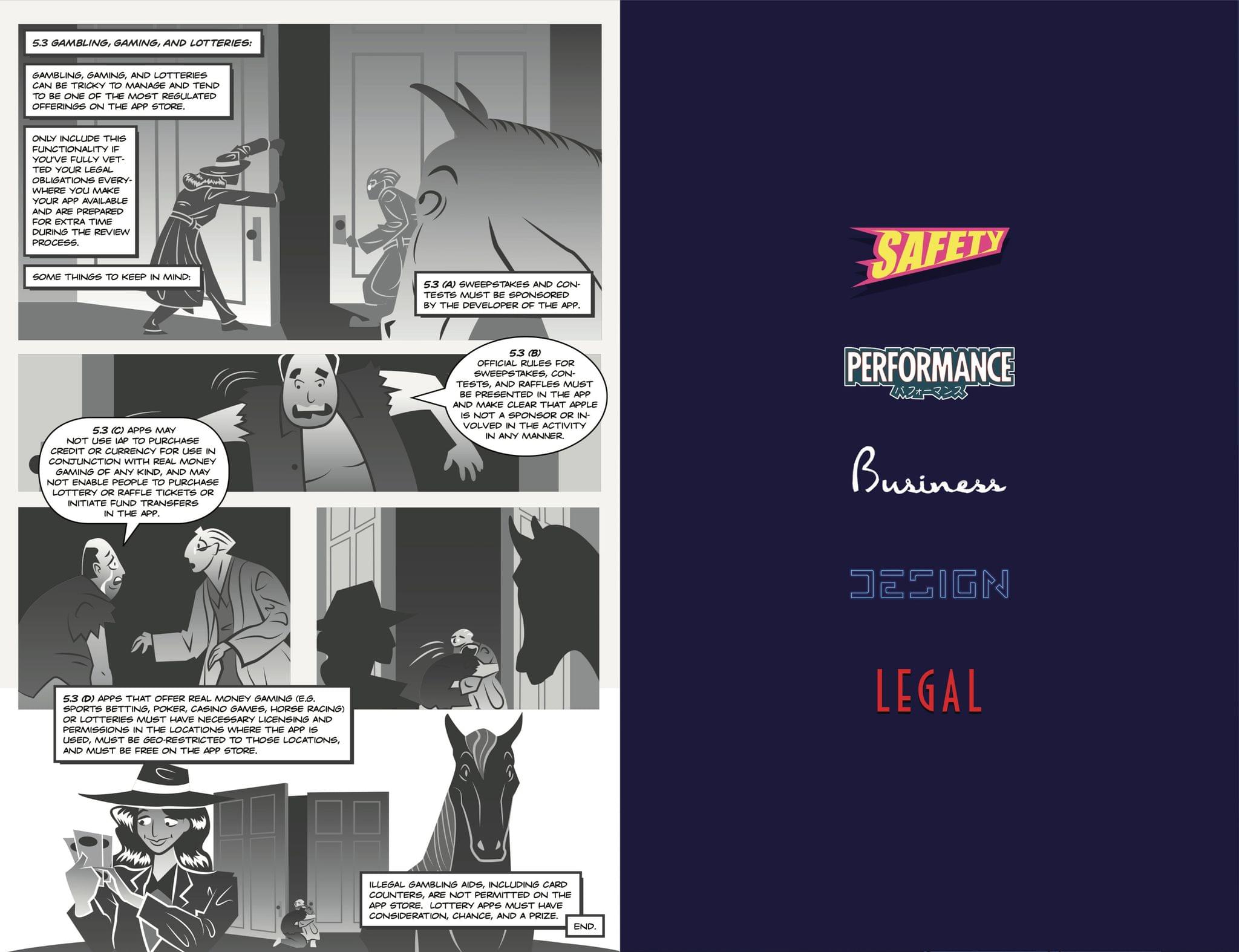

Five Years Ago, Apple Released a Comic Book of the App Store Review Guidelines
source link: https://www.macstories.net/stories/five-years-ago-apple-released-a-comic-book-of-the-app-store-review-guidelines/
Go to the source link to view the article. You can view the picture content, updated content and better typesetting reading experience. If the link is broken, please click the button below to view the snapshot at that time.

Five Years Ago, Apple Released a Comic Book of the App Store Review Guidelines
It has become commonplace for Apple’s App Store Review Guidelines to be revised throughout the year, but WWDC often brings the biggest changes. However, no WWDC brought bigger changes than WWDC 2016. Five years ago yesterday, Apple unveiled a completely rewritten set of guidelines, and to go with it, the company released…
… a comic book.
Design and Legal.
That’s right, a comic book, divided into five chapters covering each of the sections of the guidelines. According to App Store Review Guidelines History, a site that has been tracking changes to the guidelines since 2014, WWDC 2016 saw a reduction from 30 to just five sections: Safety, Performance, Business, Design, and Legal. However, despite the simplified structure, the word count of the guidelines increased from around 5,000 words to over 6,000.
A big part of the App Store Review Guidelines’ expansion was thanks to app subscriptions, which, previously, were only available to media content and services apps. Subscriptions weren’t the only big change announced in 2016, though. WWDC also saw the introduction of App Store search ads and many other changes.

In 2016, the ADAs and the App Store Review Guidelines comic book were introduced by Apple’s John Geleynse.
The massive changes to the App Store Review Guidelines went live shortly after Apple’s opening WWDC keynote. Later the same day, I covered the annual Apple Design Awards for MacStories. The format of the awards has changed over the years, but 2016 was a straightforward presentation of the winners, including long-time MacStories favorites Streaks and Ulysses. However, after all the awards had been handed out, John Geleynse, who was Apple’s Director of Technology Evangelism & User Experience at the time, threw a curve ball at the audience attending the event in San Francisco’s Moscone Center with this cryptic introduction:
But before we wrap up tonight, we just wanted to tell you about something else that we’ve been working on that’s fun. And it’s a little bit apart from the Design Awards that we’ve given out so far, but it’s a great way to end our day. And it does tie into building something that’s fun, and unique, and compelling.

ADA attendees received a physical copy of the App Store Review Guidelines Comic Book.
With that, Ben Wolstenholme, CEO of Madefire, which made motion comics for the iPhone, iPad, and Apple TV, took the stage and introduced the App Store Review Guidelines comic book. Wolstenholme explained that his company had worked with five different artists to bring each of the five sections of the guidelines to life. Developers who attended the ADAs were given a physical copy of the comic book, and it can still be downloaded from Apple’s website as a PDF.

Madefire demoed a motion comic version of the App Store Review Guidelines comic book.
Wolstenholme said a motion comic version would be available later in Madefire’s app, but sadly, although the app is still on the App Store and a small selection of free comics are available, Madefire is no longer in business, and the motion comic version of the App Store Guidelines is gone.

Madefire’s CEO shows off the five mini-comics that make up App Store Review Guidelines comic book.
The announcement seemed to catch the developers in the room a little off guard, but awkward chuckles soon gave way to enthusiasm for the effort that obviously went into the strange project. Each of the five chapters of the guidelines was handed over to a different illustrator who was tasked with bringing the guidelines’ rather dry topics to life.

A space monster is saved from unsafe App Store content while a fight breaks out over beta testing.
The Safety chapter depicts the hero saving a space monster that chokes on objectionable user-generated content or space rocks, depending on your point of view. The moral of the story of the Performance chapter seems to be, ‘If you use the App Store for beta testing instead of TestFlight, you could find yourself in the middle of a Pokémon-style battle.’

Step into a barbershop where App Store business models are the topic of the day, then visit a desolate planet where robots will warn you about creating multiple bundle IDs.
In the Business chapter, everyone is all smiles at the local barbershop as the barber warns children against manipulating App Store reviews. I’m not sure what it has to do with Design, but apparently, you can meet and befriend an army of robots in a dystopian world as long as you don’t spam people with your app.

I’m still trying to figure out what’s up with the horse that makes an appearance on the final page of the comic.
Finally, the Legal section of the comic ends on a noir note, with a detective looking for someone who probably forgot to sign their banking or tax agreements in App Store Connect.
In all seriousness, though, the changes to the App Store Review Guidelines in 2016 were much-needed at the time, and Apple needed to get the word out about them. The new rules reset the baseline, and the comic book was an attempt to familiarize developers with the updates in a fun and friendly way.
Inevitably like all quasi-legal documents (see, e.g., The Bill of Rickies), the changes to the App Store Review Guidelines also created new ambiguities, and in the years since, have ballooned to over twice the length they were in 2016. The comic book was a goofy, quirky attempt to connect with developers over how the App Store is run, which makes it easy to poke fun at. However, the idea of reconsidering the Guidelines from a fresh perspective and exploring new ways to engage developers over them is something I’d like to see Apple revisit.
Recommend
About Joyk
Aggregate valuable and interesting links.
Joyk means Joy of geeK